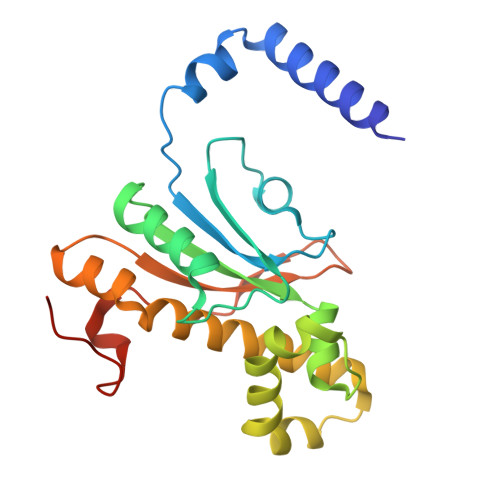Structure and inhibition studies of a type II beta-carbonic anhydrase psCA3 from Pseudomonas aeruginosa.
Pinard, M.A., Lotlikar, S.R., Boone, C.D., Vullo, D., Supuran, C.T., Patrauchan, M.A., McKenna, R.(2015) Bioorg Med Chem 23: 4831-4838
- PubMed: 26068018
- DOI: https://doi.org/10.1016/j.bmc.2015.05.029
- Primary Citation of Related Structures:
4RXY - PubMed Abstract:
Carbonic anhydrases (CAs) are metallo-enzymes that catalyze the reversible hydration of carbon dioxide into bicarbonate and a proton. The β-class CAs (β-CAs) are expressed in prokaryotes, fungi, plants, and more recently have been isolated in some animals. The β-CA class is divided into two subclasses, termed type I and II, defined by pH catalytic activity profile and active site structural configuration. Type I β-CAs display catalytic activity over a broad pH range (6.5-9.0) with the active site zinc tetrahedrally coordinated by three amino acids and a hydroxide/water. In contrast, type II β-CAs are catalytically active only at a pH 8 and higher where they adopt a functional active site configuration like that of type I. However, below pH 8 they are conformationally self-inactivated by the addition of a fourth amino acid coordinating the zinc and thereby displacing the zinc bound solvent. We have determined the structure of psCA3, a type II β-CA, isolated from Pseudomonas aeruginosa (P. aeruginosa) PAO1 at pH 8.3, in its open active state to a resolution of 1.9 Å. The active site zinc is coordinated by Cys42, His98, Cys101 and a water/hydroxide molecule. P. aeruginosa is a multi-drug resistant bacterium and displays intrinsic resistance to most of the currently used antibiotics; therefore, there is a need for new antibacterial targets. Kinetic data confirm that psCA3 belongs to the type II subclass and that sulfamide, sulfamic acid, phenylboronic acid and phenylarsonic acid are micromolar inhibitors. In vivo studies identified that among six tested inhibitors representing sulfonamides, inorganic anions, and small molecules, acetazolamide has the most significant dose-dependent inhibitory effect on P. aeruginosa growth.
Organizational Affiliation:
Department of Biochemistry and Molecular Biology, College of Medicine, University of Florida, Gainesville, FL 32610, USA.
















